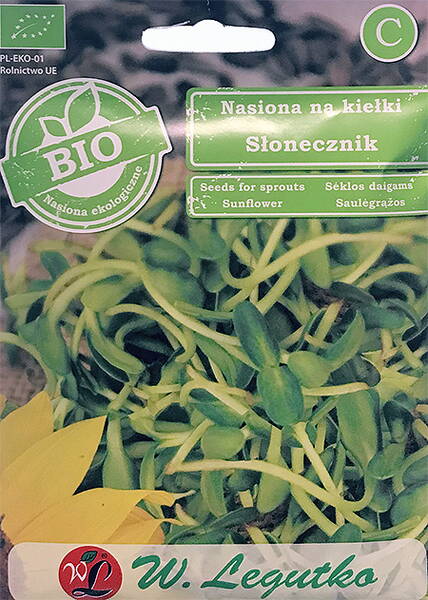Bright and appetizing microgreens of sunflower are an exquisite and valuable gift from nature.
Young sprouts contain a huge amount of useful trace elements, vitamins and amino acids. Regular consumption of food contributes to the overall health of the body and weight loss.
Microgreens have a pronounced salad flavor with a subtle buttery aftertaste. Freshly cut sprouts are used in salads, for making sandwiches, added to fresh vegetables.
Ready to cut and eat 7-10 days after sowing!
Research by scientists has shown that sprouted sunflower seeds are much healthier than dry seeds.
Sprouted sunflower regulates cholesterol metabolism in the body, which is very valuable for those with high blood cholesterol.
It also strengthens the walls of blood vessels, improves the acid-base balance, has an excellent preventive and therapeutic effect in hypovitaminosis and vitamin deficiency, and regulates the work of the nervous system. Due to the high content of vitamin E, sunflower seedlings are very useful in violation of the reproductive functions of the body.
Sunflower sprouts help to maintain good eyesight, prevent blood clots, compensate for the lack of vitamins and minerals, improve the condition of the skin and mucous membranes of the gastrointestinal tract, therefore sunflower sprouts are so useful in treating gastrointestinal diseases and dysbiosis.
Strengthens the nervous system and immunity. It has a beneficial effect on the brain and slows down the aging process of the body.
Nutritional value of sunflower seedlings:
- vitamin complex (ascorbic acid, carotene, D, E, K and B vitamins: B1, B2, B3, B5, biotin, B6, folic acid)
- macro- and microelements (magnesium, potassium, iodine, selenium, phosphorus, fluorine, calcium, copper, manganese, cobalt, zinc, molybdenum)
- contains lecithin, unsaturated fatty acids (linoleic, palmitic, oleic).
Optimum sprout length: 0.5 - 1 cm.
Storage: refrigerated for up to 5 days.
* Technology of growing microgreens at home in the soil:
1. Pour a layer of soil 1.5 to 4 centimeters thick onto the bottom of the prepared container.
2. Moisten the soil with a sprayer.
3. Next, sow the microgreen seeds over the entire area of the substrate, without placing them too tightly.
4. After this, press down the seed material with your palm and pour another small layer of soil on top.
5. When growing, make sure that the soil layer does not reach the edges of the container so that the microgreen shoots can rest on the walls.
6. To ensure better contact of the seeds with the soil, compact the soil.
7. Next, spray the soil with water using a spray bottle.
8. Close the container using a transparent lid, or film or a plastic bag with a low density.
9. Place the container for forcing microgreens on the tray and keep it in a warm, dark place until the first sprouts appear.
10. After the seedlings appear (after 2-3 days), move the container with miniature plants to the light.
To grow microgreens in the ground, it is necessary to maintain room temperature and water as needed to prevent the seeds from washing out to the surface.












